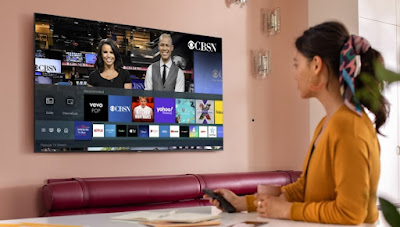Samsung TV - Analysis and Buying Guide - 2023
A well-known brand can be a real guarantee when making a large investment in electronics. Brand-name devices sometimes cost a bit more, but they also tend to offer the latest innovations and reliability. You can count on good performance from these devices for a long time.
In the world of big screen TVs, the Samsung brand occupies a place at the top of the market. This electronics manufacturer has all kinds of TV designs for sale, which will surely allow you to find one that fits your needs.
At Real Indian we carry out a detailed investigation of each category of products, including Samsung televisions. Our tests and reviews provide us with the data for a deep understanding of a product's pros and cons, and we pride ourselves on giving our readers the reliable information they need to make smart purchasing decisions.
You can count on our product selections and reviews to be free from bias, because we don't take free samples from manufacturers. When you're ready to buy, check out the Samsung TVs we recommend in our product list above. Also read our buying guide, and we will help you find the Samsung TV that best suits your needs.
Samsung TV Layouts
There are a few different screen layout options available from Samsung. Some of these designs are only useful in certain situations, so think about how you will use the TV and then decide if you want to spend the extra money to get those design features.
- 3D :
You'll be hard-pressed to find a Samsung 3D TV on store shelves, though some older models are still out there. Samsung recently stopped making 3D TVs.
- Curved :
Samsung offers quite a few curved screen TVs. The choice to buy a curved or flat screen Samsung TV will be a personal choice as there are significant benefits to one over the other. Some people like the immersive experience a curved screen provides—it almost feels like the screen surrounds you when you sit in front of it. Aside from the immersive feel that some like, there's not much difference between curved and flat screens.
- LED backlight :
Most Samsung TVs use an LED backlight. This type of backlighting produces a high level of image quality and the best levels of contrast on the screen. Look for an LED backlight that uses a full-array layout, rather than an edge backlight. Full matrix backlighting uses lights across the entire screen. This produces greater image and color uniformity across the screen. You'll pay a bit more for the full-array LED backlight, but it vastly improves image quality.
If you're a bit confused about how LED and LCD are related, think of it this way. LCD is the technology in the display screen that creates the actual image. However, LCD technology does not itself generate light. Manufacturers use a backlight that shines light through the LCD, allowing you to see the image. This backlight consists of LED lights. In essence, all LED TVs are also LCD TVs.
So if you see a Samsung TV described as LED-LCD technology, it has an LCD screen with an LED backlight. This is the most common type of TV on the market.
Samsung TV Maximum Resolutions
Samsung TVs are available with a few full resolution options. Generally, people want the highest resolution they can afford. The reason is quite simple: more pixels provide a sharper image.
- 720p :
This resolution of 1280x720 pixels is an HD (or high definition) screen resolution. However, it is not as sharp as 1080HD resolution. Very few TVs offer only 720p as the maximum resolution anymore. You'll typically see 720p limited to smaller Samsung TV screens, like 32 inches or smaller.
- 1080p :
This highest HD resolution consists of 1920x1080 pixels, and is sometimes called full HD. It is a sharper resolution than 720p. You'll find Full HD resolution available on all kinds of screen sizes, up to 55 or 60 inches. As a general rule of thumb, 1080p resolution will be cheaper than 4K resolution on the same screen size, but the difference between the two price points has become very small.
You may wonder why you need a 4K TV when there is so little native 4K resolution programming available. Aside from the increasing amount of content being created for 4K, many 4K TVs include upscaling technology: HD resolution programming will be scaled to fit the 4K TV's resolution. In short, even content that was recorded in “regular” HD, at 1920x1080, will look noticeably better on a 4K TV.
Samsung Display Technologies
Samsung offers some newer display technologies that provide you with a better viewing experience. We'll walk you through a couple of the different display options you'll have from Samsung.
QLED :
Samsung's most advanced display technology, QLED, also commands the highest price. QLED is short for Quantum Dot LED. This technology adds a film consisting of quantum dots (semiconductor nanocrystals) between the LED backlight and the LCD portion of the screen. The dots provide much more vibrant colors than standard LCD.
We should mention that quite a few industry insiders believe that these display technology acronyms are more about marketing than delivering quality images. There's no question that these screens outperform Samsung's entry-level LED-backlit screens, but it's not a bad idea to do demos before deciding that QLED or SUHD offer enough of a difference to be worth the higher price.
Read More :

